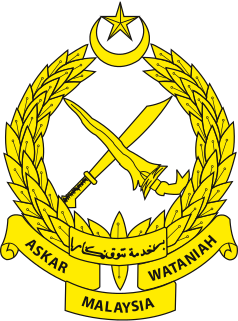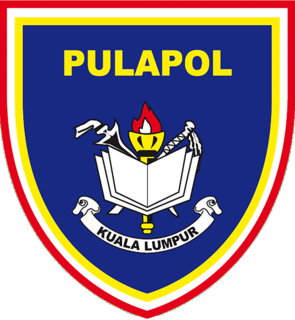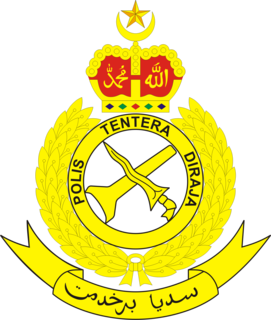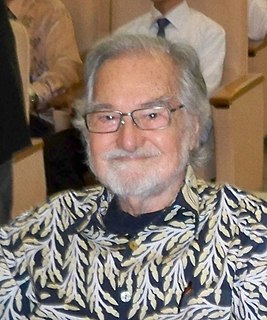
Kajang is a town in Hulu Langat District, Selangor, Malaysia.

The Rejimen Askar Wataniah is the military reserve force of the Malaysian Army.

The Malaysian Police Training Centre is the oldest police academy in Malaysia and the training institute for Royal Malaysia Police. It is located at Semarak Street, Kuala Lumpur. It is the place where the police is trained under the government. Learning in Pulapol encompasses training aspect, from academic or practical. Pulapol has seven branches: Pulapol Jalan Semarak, Kuala Lumpur, Pulapol Bukit Sentosa, Rawang, Pulapol Air Hitam, Negeri Sembilan, Pulapol Segamat, Johor, Pulapol Langkawi, Kedah, Pulapol Dungun, Terengganu, Pulapol Kota Kinabalu, Sabah and Pulapol Kuching, Sarawak. The police trainees will be guaranteed to have a job and will be trained for six or nine months there.

The Kor Polis Tentera DiRaja is the military police branch of the Malaysian Army. Referred to as the "Redcaps" like their British counterpart or, more popularly, known as "MPs", the Kor Polis Tentera DiRaja keep discipline within the Army ranks and ensure security at Malaysian Army installations.

Port Klang Line is one of the three KTM Komuter Central Sector lines provided by Keretapi Tanah Melayu. The electric trains run between Tanjung Malim and Port Klang. Prior to 15 December 2015, the northern terminus of this line was Batu Caves.

Ungku Abdul Aziz bin Ungku Abdul Hamid was a Malaysian economist and lecturer. He was the 3rd Vice-Chancellor of the University of Malaya from 1968 to 1988 and the 1st General Director of the Council on Language and Literature of Malaysia from 1956 until 1957. He was awarded the title of Royal Professor in 1978.

The Royal Malaysia Police, is a (primarily) uniformed national and federal police force in Malaysia. The force is a centralised organisation. Its headquarters are located at Bukit Aman, Kuala Lumpur. The police force is led by an Inspector-General of Police (IGP) who, as of 4 May 2021, is Acryl Sani Abdullah Sani.

The Royal Malaysia Police Museum is a museum that showcases the history of the Royal Malaysia Police, located in Kuala Lumpur, Malaysia. The museum includes exhibits from the history of the Royal Malaysia Police since its origins under British colonial rule until the 1970s. It is open daily, except Monday, from 1000 to 1800 hours, and admission is free.
The Royal Malaysian Police College Kuala Lumpur is a police educational institution located in Kuala Lumpur, Malaysia. It is responsible for training senior officers in the Royal Malaysia Police and the Malaysian Armed Forces. The College also trains police officers and soldiers from Singapore, Brunei, Thailand, Russia, the United Kingdom and the United States.

The General Operations Force is the light infantry arm of the Royal Malaysia Police. The General Operations Force was established in 1948 during the Malayan Emergency by the British Administration when Malaya was a colony. The police service was mobilised to the field role, primarily to engaging Communist guerrillas during the emerging Insurgency. When Malaysia was formed in 1963, this law enforcement unit was then known as the Police Field Force. The title was adopted when it dropped the previous handle widely referred to as the Jungle Squad.
The Police Volunteer Reserve (PVR) is a team of special police as well as a supporting unit of the full-time Royal Malaysian Police force where normal citizens could volunteer to help to maintain peace and security of their respective formation. The PVR is mainly composed of professionals such as the architects, engineers, lawyers, teachers, doctors, businessmen and senior government officers. Under the National Blue Ocean Strategies, PVR is targeted to have 50,000 members from all sectors in 2017.

The Seremban Line or Seremban Komuter Line is one of the three KTM Komuter Central Sector lines provided by Keretapi Tanah Melayu. Its electric trains run between Batu Caves and Pulau Sebang/Tampin, with some services terminating in Seremban. Prior to 15 December 2015, the northern terminus of this line was Rawang.
Tun Mohammed Hanif bin Omar is a retired Malaysian police officer who served as the 4th Inspector-General of Royal Malaysia Police from 8 June 1974 to 15 January 1994 and also the longest serving Inspector General of Police in Malaysia for 20 years.

The Special Actions Unit, commonly known as and abbreviated to UTK is a tactical unit of the Royal Malaysia Police (RMP). The unit is headquartered at the RMP buildings in Bukit Aman, Kuala Lumpur. Together with the 69 Commando, they form the Pasukan Gerakan Khas.

The Inspector-General of Police, also known as the Chief of Police, is the highest-ranking police officer of the Royal Malaysian Police. Assisted by the Deputy Inspector-General of Police, he reports to the Minister of Home Affairs. The IGP is based at Bukit Aman, Kuala Lumpur which is the Headquarters of the RMP.

Bukit Kutu or Treacher Hill is a former hill station and now a ghost town in Selangor, Malaysia, about 70 km (43 mi) north of Kuala Lumpur. This hill station was established in 1893 and consisted of two bungalows, which served as a lodge for visitors and included a 15.3 km (9.5 mi) bridle path that connected it with the town of Kuala Kubu. The hill station was abandoned in 1935 and the government of British Malaya acquired the station's bungalows which were sold as they no longer paid their way. The Japanese army later bombed the station during World War II, leaving it a ghost town. Since the abandonment of the hill station, it has become a popular hiking destination and is busiest during weekends. Bukit Kutu has a rich biodiversity with various kinds of flora and fauna which led to its gazettement as a wildlife reserve in 1922.
Tan Sri Abdul Rahim bin Mohd. Noor is the fifth Inspector-General of Police of Royal Malaysia Police and served from 16 January 1994 until 7 January 1999.
Tan Sri Mohd Zaman Khan bin Rahim Khan was a former Malaysian police officer. Although he was never appointed to the top position of the Malaysian Police, he was well-known for handling many high-profile cases in the 1990s, such as the Mona Fandey murder case, bringing down local gangster P. Kalimuthu, and helping to coordinate rescue efforts during the Highland Towers apartment collapse.
Tan Sri Shamsuri bin Arshad is a former Deputy Inspector General of Police of Malaysia.














